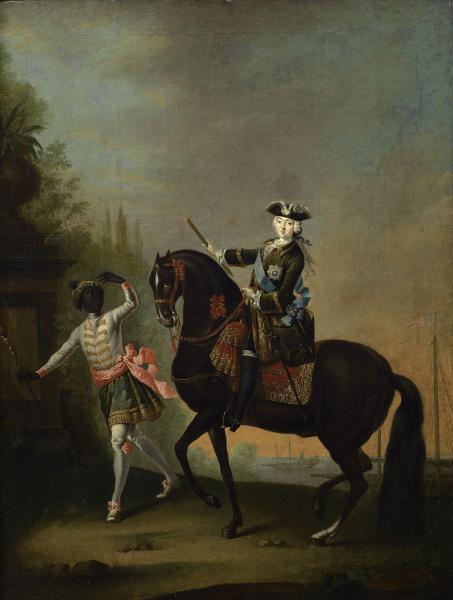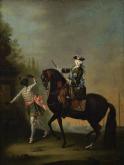Equestrian Portrait of the Empress Elizabeth Petrovna with a Little Negro Footboy
Copy of an original by Georg Christoph Grooth (Tret. Gal., 1743). 1757
- oil on canvas. 78,5 х 60
- Ж-11371
Пост. в 1985 от Е. Ф. Вишневского (Москва); ранее (до1979) — собр. Ф. Е. Вишневского (Москва)
- Period 18th century
- CategoryPortrait
- Share
Empress Elizabeth I Petrovna (1709–1761) was the daughter of Peter the Great and Catherine Alexeyevna, née Marta Skowrońska. She was considered illegitimate, but after the official wedding of her parents in 1712 she began to bear the title of Tsesarevna. Later on this detail of her biography would prevent her from marrying a European prince. She ascended to the throne on 25 November 1741 following a palace coup carried out with the support of the Guards. She waged successful wars against Sweden (1741–1743) and Prussia (the Seven Years’ War, 1756–1763). Her domestic policies were marked by an extension in the rights of the gentry to own land and peasants, but at the same time the death penalty was abolished (1756) and the use of torture was reduced. Elizabeth was famous for her beauty, her merry disposition and her love of luxury and entertainment; her wardrobe contained as many as 12,000 dresses. The tastes of the Empress and her favourites helped the development of art and enlightenment. The network of primary schools in Russia was enlarged, military training schools were reorganised and the first grammar schools were opened. Moscow University was founded in 1755, and the Academy of Arts opened its doors in St Petersburg in 1757. The capital and its environs were decorated with magnificent palaces and churches in the baroque style. The Empress probably had no children, but she was possibly secretly married to Count Alexei Razumovsky, whom she had raised from among the court choristers.
This portrait, painted by the German artist Lucas Conrad Pfandzelt, depicts Elizaveta Petrovna on horseback in the uniform of the Preobrazhensky Life Guards regiment, with the order of St. Andrew (ribbon and star). On her right, a little negro footboy is standing in a theatrical pose. The portrait is a copy of the original painted by Georg Christoph Grooth (1743; the Tretyakov Gallery), under whom the artist studied. It is the companion portrait to the Equestrian portrait of Grand Duke Peter Fedorovich, 1747 (?) (The State Russian Museum, ZH-11370.)

